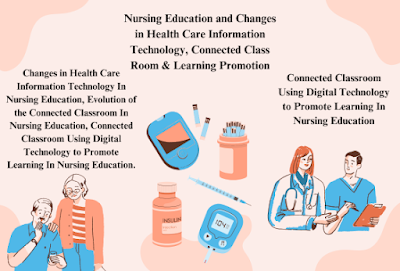The Changes in Health Care Information Technology Connected Class Room and Learning Promotion In Nursing Education. A variety of innovative technologies are used in nursing education, such as virtual reality, simulations, and online learning platforms. These technological advancements promote student engagement, creativity, and critical thinking through immersive virtual learning experiences.
The Changes in Health Care Information Technology Connected Class Room and Learning Promotion In Nursing Education
The integration of health information technology (HIT) into nursing education has significantly changed the learning landscape. Connected classrooms and online resources promote student engagement, access to information, and the development of critical skills for modern healthcare professionals. These changes are driven by the need to prepare nurses for an ever-evolving healthcare environment and harness the power of technology to improve learning outcomes.
Promotion In Nursing Education Transformations in Health Care Information Technology
The integration of advanced technologies has significantly transformed nursing education and practice. As new tools emerge for patient assessment, medication administration, and documentation, nursing education must adapt to these changes to prepare future healthcare professionals effectively. Key developments in health care information technology include:
- Enhanced Patient Monitoring: New technologies facilitate advanced methods for assessing and monitoring patients. From wearable devices to sophisticated monitoring systems, these tools provide real-time data and improve patient care.
- Electronic Health Records (EHRs): The shift from paper-based documentation to EHRs has revolutionized how patient information is recorded and shared. EHRs not only streamline documentation but also integrate decision-making tools, providing nurses with reminders and resources to enhance patient care.
- Mobile Technology: Communication and decision-making have evolved with mobile devices. Nurses and healthcare providers now use smartphones and tablets for voice calls, text messaging, and accessing clinical decision-making algorithms.
- Access to Evidence-Based Literature: The availability of digital libraries and mobile access to scholarly articles has replaced the need for physical trips to libraries, making it easier for nurses to stay updated with the latest research.
- Consumer Health Applications: Patients are increasingly engaged in their healthcare through apps and online platforms, contributing to a more personalized and proactive approach to health management.
The Connected Classroom in Nursing Education
In response to these technological advancements, the concept of the “connected classroom” has emerged, redefining how nursing education is delivered. This approach leverages digital technology to create an interactive and resource-rich learning environment. Key aspects of the connected classroom include:
- Physical and Virtual Spaces: The connected classroom integrates both physical and virtual elements, enabling students and faculty to interact with digital resources and clinical practice sites beyond the traditional classroom setting.
- Digital Learning Technologies: Tools such as online simulations, virtual labs, and interactive case studies are used to enhance learning experiences. These technologies help students engage with course material and prepare for real-world clinical situations.
- Preparation for a Global Health Care System: As health care services increasingly move to community settings, the connected classroom prepares students for diverse practice environments, including home care, assisted living facilities, and schools.
- Facilitating Connections: The connected classroom supports the role of nursing faculty in facilitating connections between students and resources, experts, and clinical practice sites, enhancing the learning experience and bridging the gap between theory and practice.
Evolution of the Connected Classroom
The evolution of the connected classroom has been driven by several factors:
- Technological Advancements: Social changes and the rise of digital technology have reshaped nursing education. The need for new pedagogies and evidence-based teaching practices has led to the development of connected classrooms.
- Technology-Savvy Students and Faculty: The increasing familiarity with technology among students and faculty has prompted the integration of digital tools into nursing curricula, enhancing both teaching and learning processes (Abel, Brown, & Suess, 2013).
Challenges and Opportunities
The integration of health care information technology into nursing education presents several challenges and opportunities:
- Updating Teaching Methods: Traditional teaching methods may no longer suffice for preparing students to use new technologies. Faculty must adapt their teaching approaches to include training on the latest tools and technologies.
- Faculty Development: Nursing faculty need to develop expertise in using and teaching new technologies. Professional development opportunities and technology support can aid in this transition.
- Student Preparation: Students must learn to use new technologies effectively in both classroom and clinical settings. This requires hands-on training and exposure to real-world applications of digital tools.
In conclusion, the integration of advanced health care information technology and the evolution of the connected classroom are transforming nursing education. By embracing these changes, nursing programs can better prepare students for the complexities of modern healthcare, ensuring they are equipped with the skills and knowledge needed to excel in their professional roles.
Read More:
https://nurseseducator.com/didactic-and-dialectic-teaching-rationale-for-team-based-learning/
https://nurseseducator.com/high-fidelity-simulation-use-in-nursing-education/
First NCLEX Exam Center In Pakistan From Lahore (Mall of Lahore) to the Global Nursing
Categories of Journals: W, X, Y and Z Category Journal In Nursing Education
AI in Healthcare Content Creation: A Double-Edged Sword and Scary
Social Links:
https://www.facebook.com/nurseseducator/
https://www.instagram.com/nurseseducator/
https://www.pinterest.com/NursesEducator/
https://www.linkedin.com/in/nurseseducator/
https://www.researchgate.net/profile/Afza-Lal-Din
https://scholar.google.com/citations?hl=en&user=F0XY9vQAAAAJ
